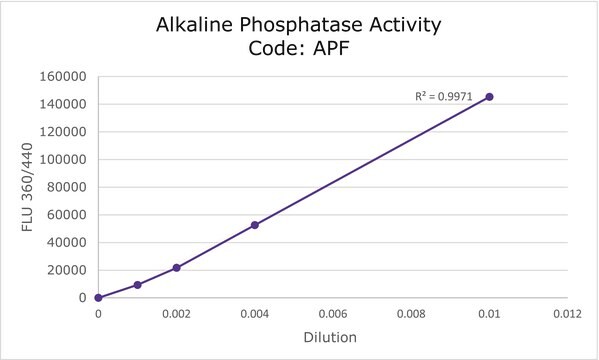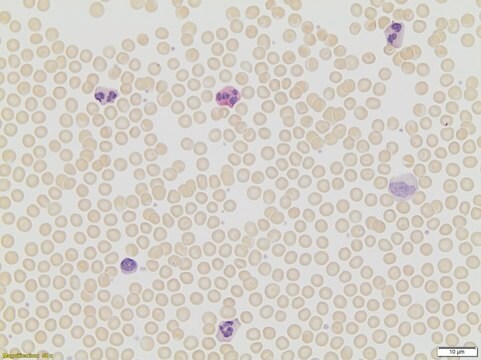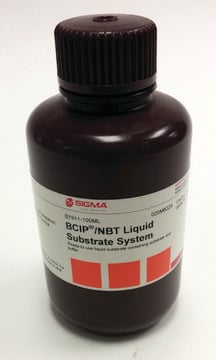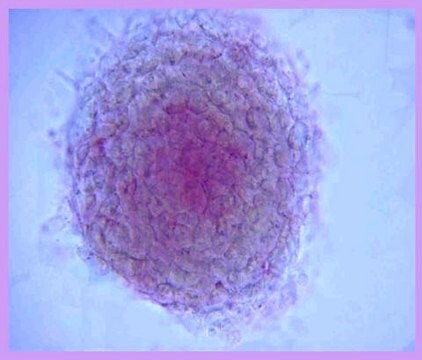SCR066
Quantitative Alkaline Phosphatase ES Characterization Kit
This Quantitative Alkaline Phosphatase Embryonic Stem (ES) Characterization Kit easily quantifies the amount of alkaline phosphatase present within their embryonic stem cell cultures using a convenient 96-well colorimetric enzymatic assay.
登入查看組織和合約定價
全部照片(1)
About This Item
分類程式碼代碼:
12352207
eCl@ss:
32161000
NACRES:
NA.81
推薦產品
品質等級
物種活性(以同源性預測)
mammals
製造商/商標名
Chemicon®
技術
cell culture | stem cell: suitable
輸入
sample type: human embryonic stem cell(s)
sample type cardiac stem cell(s)
sample type neural stem cell(s)
sample type hematopoietic stem cell(s)
sample type epithelial cells
sample type mesenchymal stem cell(s)
sample type pancreatic stem cell(s)
sample type: mouse embryonic stem cell(s)
sample type induced pluripotent stem cell(s)
一般說明
Embryonic stem (ES) cells are pluripotent cells derived from the inner cell mass (ICM) of preimplantation embryos and are capable of unlimited, undifferentiated proliferation in vitro under appropriate cell culture conditions. Undifferentiated embryonic stem cells are characterized by high expression levels of stage-specific embryonic antigens (SSEA-1, 3 and 4), tumor rejection antigens (TRA-1-60 and TRA-1-81), OCT-4 and alkaline phosphatase. These undifferentiated markers are downregulated upon spontaneous or induced differentiation.
Alkaline phosphatase (ALP) is a hydrolase enzyme responsible for dephosphorylating molecules such as nucleotides, proteins, and alkaloids under alkaline conditions. The enzyme is present within all tissues of the body but is elevated in cells of the liver, kidney, bone, placenta, embryo and under specific disease states. Under alkaline conditions (pH>10), ALP can catalyze the hydrolysis of p-nitrophenylphosphate (p-NPP) into phosphate and p-nitrophenol, a yellow colored by-product of the catalytic reaction. The amount of p-nitrophenol produced is proportional to the amount of alkaline phosphatase present within the reaction. The amount of ALP can thus be reliably quantified by reading the amount of p-nitrophenol amassed after the catalytic reaction at 405 nm on a spectrophotometer.
Alkaline phosphatase (ALP) is a hydrolase enzyme responsible for dephosphorylating molecules such as nucleotides, proteins, and alkaloids under alkaline conditions. The enzyme is present within all tissues of the body but is elevated in cells of the liver, kidney, bone, placenta, embryo and under specific disease states. Under alkaline conditions (pH>10), ALP can catalyze the hydrolysis of p-nitrophenylphosphate (p-NPP) into phosphate and p-nitrophenol, a yellow colored by-product of the catalytic reaction. The amount of p-nitrophenol produced is proportional to the amount of alkaline phosphatase present within the reaction. The amount of ALP can thus be reliably quantified by reading the amount of p-nitrophenol amassed after the catalytic reaction at 405 nm on a spectrophotometer.
Millipore’s Quantitative Alkaline Phosphatase ES Characterization Kit allows researchers to easily quantify the amount of alkaline phosphatase present within their embryonic stem cell cultures using a convenient 96-well colorimetric enzymatic assay. This kit can be used in conjunction with Millipore’s Alkaline Phosphatase Detection kit (Cat. No. SCR004) to fully characterize the levels of alkaline phosphatase present within an embryonic stem cell culture.
應用
Research Category
Stem Cell Research
Stem Cell Research
This Quantitative Alkaline Phosphatase Embryonic Stem (ES) Characterization Kit easily quantifies the amount of alkaline phosphatase present within their embryonic stem cell cultures using a convenient 96-well colorimetric enzymatic assay.
成分
p-NPP Substrate Concentrate (50X): (Part No. ES008-200UL) 200 μL
p-NPP Buffer: (Part No. ES011-10ML) 10 mL
Reaction Stop Solution: (Part No.CS200653) 5 mL
1X Wash Solution: (Part No. CS200652) 2 X 125 mL
Recombinant Alkaline Phosphatase Standard: (Part No. CS200654) 0.5 μg (10 μg/mL)
p-NPP Buffer: (Part No. ES011-10ML) 10 mL
Reaction Stop Solution: (Part No.CS200653) 5 mL
1X Wash Solution: (Part No. CS200652) 2 X 125 mL
Recombinant Alkaline Phosphatase Standard: (Part No. CS200654) 0.5 μg (10 μg/mL)
儲存和穩定性
All reagents are to be stored at 2∘ to 8∘C until expiration date. p-NPP substrate concentrate and p-NPP buffer are light sensitive and should not be exposed to light. Reaction stop solution contains 1N sodium hydroxide and is corrosive. Avoid skin contact and inhalation.
法律資訊
CHEMICON is a registered trademark of Merck KGaA, Darmstadt, Germany
免責聲明
Unless otherwise stated in our catalog or other company documentation accompanying the product(s), our products are intended for research use only and are not to be used for any other purpose, which includes but is not limited to, unauthorized commercial uses, in vitro diagnostic uses, ex vivo or in vivo therapeutic uses or any type of consumption or application to humans or animals.
訊號詞
Danger
危險分類
Aquatic Chronic 3 - Eye Dam. 1 - Met. Corr. 1 - Repr. 2 - Skin Corr. 1B
儲存類別代碼
8A - Combustible corrosive hazardous materials
分析證明 (COA)
輸入產品批次/批號來搜索 分析證明 (COA)。在產品’s標籤上找到批次和批號,寫有 ‘Lot’或‘Batch’.。
Ho-Chang Jeong et al.
Stem cells (Dayton, Ohio), 35(9), 2037-2049 (2017-05-26)
Basic fibroblast growth factor (bFGF) supplementation is critical to maintain the pluripotency of human pluripotent stem cells (hPSCs) through activation of PI3K/AKT, rather than MEK/ERK pathway. Thus, elaborate molecular mechanisms that preserve PI3K/AKT signaling upon bFGF stimulation may exist in
Jian Fang Liu et al.
Tissue engineering. Part A, 17(17-18), 2343-2357 (2011-05-10)
Differentiation of embryoid bodies (EBs) into particular cell lineages has been extensively studied. There is an increasing interest in the effect of soft hydrogel scaffolds on the behavior of EBs, such as the initial adhesion, dynamic morphology change, and differentiation.
Narimon Honarpour et al.
Molecular & cellular proteomics : MCP, 13(3), 780-791 (2014-01-07)
The programmed formation of specific tissues from embryonic stem cells is a major goal of regenerative medicine. To identify points of intervention in cardiac tissue formation, we performed an siRNA screen in murine embryonic stem cells to identify ubiquitin system
Mehdi Shafa et al.
Frontiers in medicine, 5, 69-69 (2018-03-31)
The discovery of reprogramming and generation of human-induced pluripotent stem cells (iPSCs) has revolutionized the field of regenerative medicine and opened new opportunities in cell replacement therapies. While generation of iPSCs represents a significant breakthrough, the clinical relevance of iPSCs
Mehdi Shafa et al.
International journal of molecular sciences, 21(1) (2019-12-28)
The clinical effectiveness of human induced pluripotent stem cells (iPSCs) is highly dependent on a few key quality characteristics including the generation of high quality cell bank, long-term genomic stability, post-thaw viability, plating efficiency, retention of pluripotency, directed differentiation, purity
我們的科學家團隊在所有研究領域都有豐富的經驗,包括生命科學、材料科學、化學合成、色譜、分析等.
聯絡技術服務









